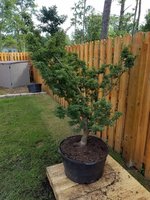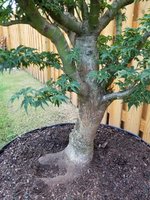AcerAddict
Shohin
Hello all. It's my first time posting here and as the title states, I'd like to get some thoughts on doing a major root cut, repot, AND air layering at the same time. I just bought this Shishigashira maple over the weekend from a local "mom and pop" garden center here in coastal southeast North Carolina. It's about 5.5 feet (1.65 m) tall from the top of the pot and the trunk is 3.5 inches (8.9 cm) in diameter just above the root base. It came in a tall, narrow 15 gallon pot, and I've already moved it into a short, wide 15 gallon pot. It was so pot bound that I had to cut the original plastic pot off to get the root ball out. I'm sure the tree appreciates an extra 2-3 inches of space all around its roots now. I only did very light teasing of the roots before putting it into the wider pot. It just has standard soil as it came from the nursery.
My plans for this tree are to air layer several of the taller branches next spring, and at the same time trim the root ball down significantly to get it into a bonsai training pot. After that, I'll have some design decisions to make before doing the major branch cuts in order to get a loose bonsai shape going. Ultimately, I want to turn this into a 24 to 36 inch (about 60-90 cm) tall bonsai. Most likely, I'll sell all the air layerings locally in order to fund the purchase of another tree.
I plan to set up the air layerings in late-March/early-April when I first start seeing new buds. Considering that Shishi's sprout air layer roots relatively fast, I'm hoping that I'll be able to cut off my new trees about 8-10 weeks later, which would be around late-May to mid-June. Is there any problem with me doing a significant cut down of the root ball at the same time I start the air layering? Or, should I leave the roots alone and wait to do my root trim and repot after I've cut the air layerings off by the end of June?
Thanks in advance, and here's some pics of the tree. Can't wait to see the fall color on this beauty!


My plans for this tree are to air layer several of the taller branches next spring, and at the same time trim the root ball down significantly to get it into a bonsai training pot. After that, I'll have some design decisions to make before doing the major branch cuts in order to get a loose bonsai shape going. Ultimately, I want to turn this into a 24 to 36 inch (about 60-90 cm) tall bonsai. Most likely, I'll sell all the air layerings locally in order to fund the purchase of another tree.
I plan to set up the air layerings in late-March/early-April when I first start seeing new buds. Considering that Shishi's sprout air layer roots relatively fast, I'm hoping that I'll be able to cut off my new trees about 8-10 weeks later, which would be around late-May to mid-June. Is there any problem with me doing a significant cut down of the root ball at the same time I start the air layering? Or, should I leave the roots alone and wait to do my root trim and repot after I've cut the air layerings off by the end of June?
Thanks in advance, and here's some pics of the tree. Can't wait to see the fall color on this beauty!



